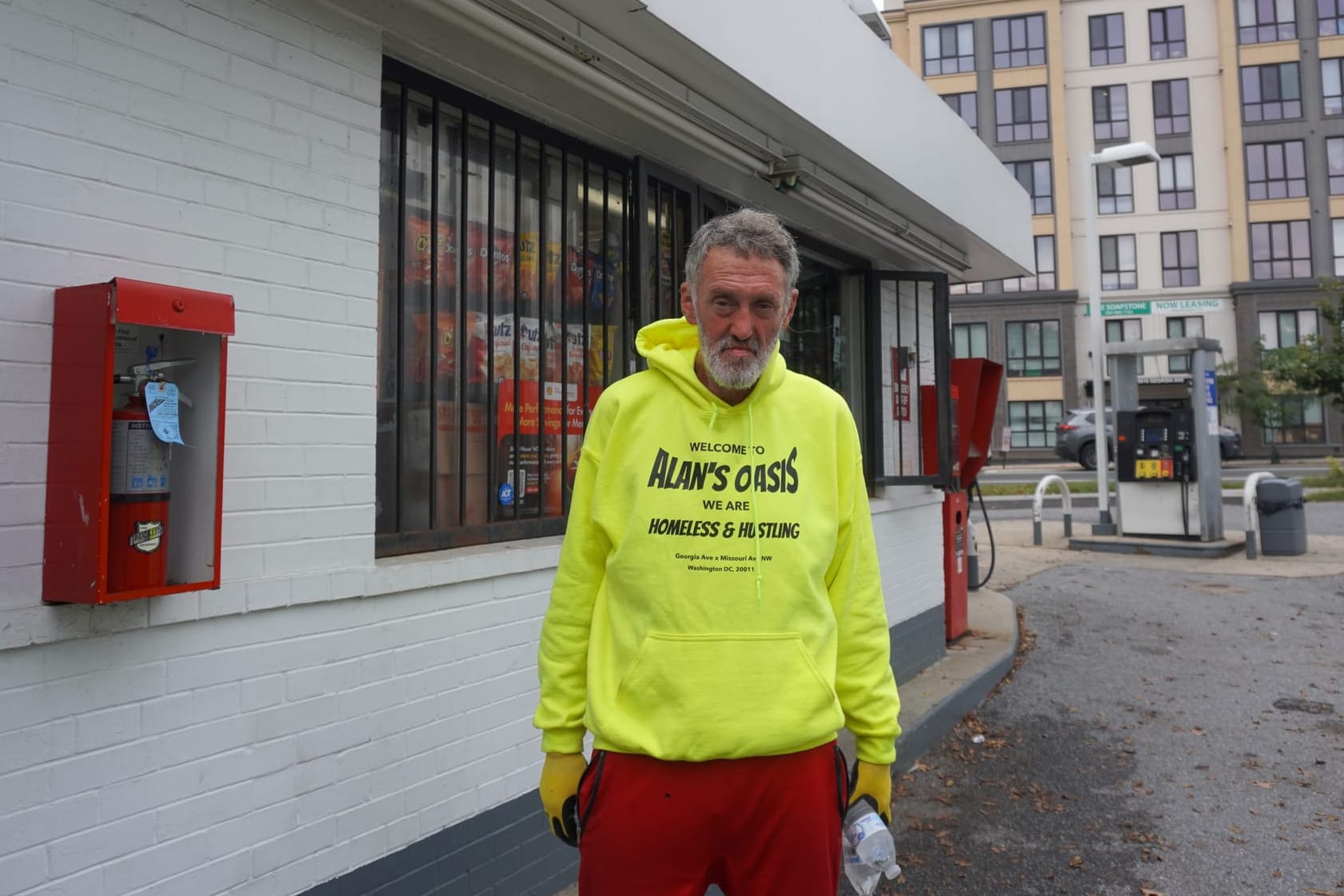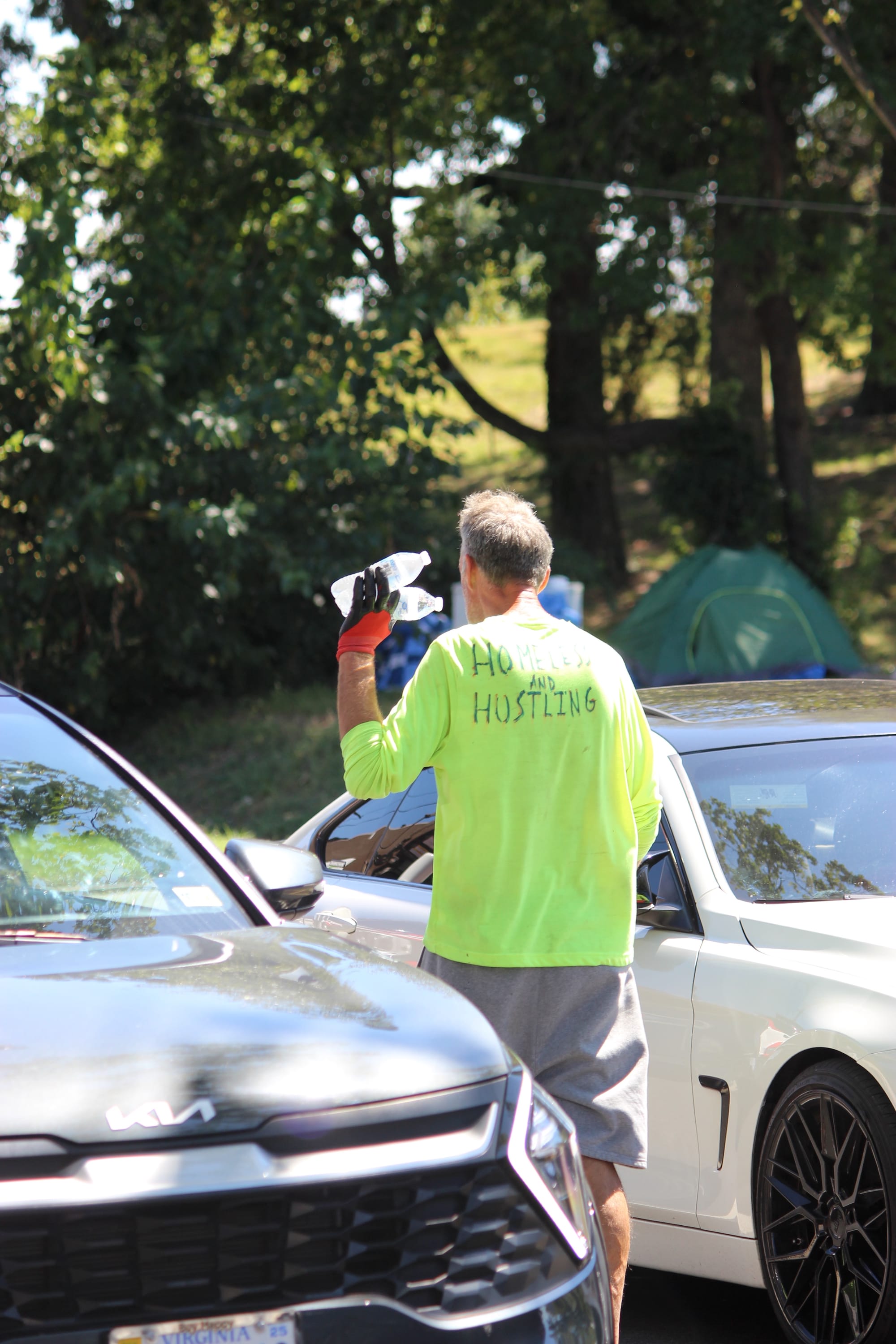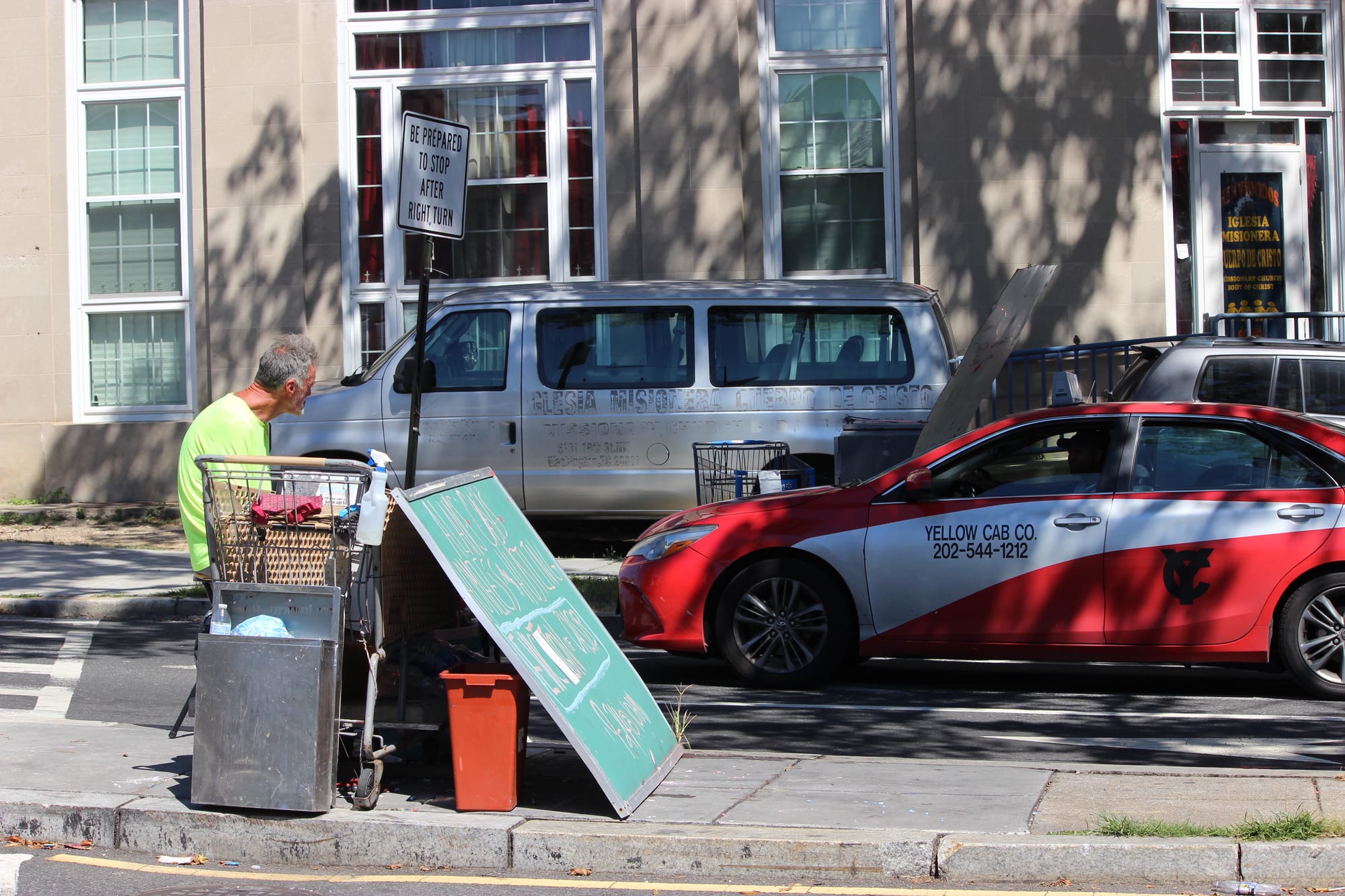The unexpected costs of running The 51st
So you're telling me ... it's more expensive to be a newsroom in D.C.?
He’s built a community that stood up for him when the threat of eviction loomed.

The cacophony of car horns and screeching brakes at the cross of Missouri and Georgia Avenues doesn’t distract Alan as he makes his way through traffic. Equipped with two bottles of water in his hands, he weaves expertly among the cars, making sure to stop and tell a passerby if their headlight is out or their gas tank door is open. Some notice his tall frame clad in a bright green shirt; others don’t, or pretend not to.
Occasionally, someone rolls a window down and Alan hands them a water. Other times, he hears the familiar lock of a car door as he walks by.
Three years ago, Alan, who goes only by his first name to protect his privacy while living outside, stood near this same intersection. He had $8 and nowhere to go. After buying a case of water and finding a cooler outside of the nearby Walmart, he went to work selling water. Within a week, he learned that if he gave the water away, people gave him more money. In an effort he calls Alan’s Oasis, he’s been giving away water at this intersection ever since.
“I now own this corner,” he says on a hot August night, standing on a hill that overlooks his intersection and his tent, set up on private property nearby with permission from the owner.
Alan thinks that he adds “a little bit of character, in a good way,” though not everyone wants Alan’s character on the streets. Some online threads have issues with him being there, and Alan occasionally encounters someone who doesn’t want him around. But through the years, Alan has garnered a dedicated client base.
For about 1,250 days, Alan has given away water at this intersection for over 12 hours a day. In his steady rhythm, he stands on the median waiting for the light on Missouri Avenue to turn red. When it does, he has 30 seconds to walk in between the two lanes of traffic before he has to escape the sudden rush of cars released by the green light. He repeats this sequence over and over until the day's traffic ends.
“I took one day off in three years. It was day 1,003,” he says.

Alan’s handmade signs speckle the sides of Missouri, announcing to drivers they have come across his oasis. On the median, a giant green chalkboard propped up against a shopping cart reads, “The price you say is the price you pay. Homeless and Hustling. If you can’t afford a water, just ask. Alan will give you one FREE. NOBODY goes thirsty at Alan’s oasis.” Those who look hard enough can make out a frowning face inside the “O” in “homeless.”
The morning of Sept. 24, day 1,242, the sign holds a different message: “Eviction of Oasis TODAY. Stand with Alan.”
Twenty days earlier, on Sept. 5, Alan returned to his station to find a notice from the Office of the Deputy Mayor for Health and Human Services (DMHHS) on his chalkboard, suggesting his encampment was marked for closure on Sept. 24.
These stickers have become a constant presence for people living outside. Each week, DMHHS clears spaces where people have set up tents and other structures to live in.
According to DMHHS records, closures and full cleanups have significantly increased in recent years as encampment engagements resumed after the pandemic. In 2021, 59% of engagements were trash-only pickups, meaning people didn’t have to move. In 2024, trash pick-ups were only 2% of engagements.
On the other hand, in 2024, there were 69 site closures versus six in 2021. Street Sense reporting in April, before the federal takeover, found that some residents were moving almost every month.
Shannon Clark, founder of Remora House, an organization supporting and advocating for the homeless community, said these closures can be traumatizing for people because they have to pack up all their belongings in a matter of hours.
“You're having to make these decisions about what to keep, what not to keep. You can't move all of it. You just can't, you don't have time,” Clark said. “It's just so dehumanizing and just horrible.”
Alan isn’t a stranger to DMHHS or closures.
Alan’s tent, which he sets up away from his oasis, has been cleared three or four times, he says, but the hydration station has historically been left alone. He says that he’s been told by DMHHS that he can have one cooler on the median, but not the sign. He believes, though, that the sign is the most important thing for his business, so he’s kept it.
If he were to move, he worries he wouldn’t make enough money. People know where to find him, he says, that’s why he has such a big client base.
“If people don’t see me for a couple of days, they cry. It’s really weird,” he says one day while he waits on the median for the light to flash red.
One stated reason behind encampment closures is that it can be a safety risk for people to live outside. An executive order from President Donald Trump on July 24 called for “encampment removal efforts in areas for which public safety is at risk.” DMHHS often lists health and safety as a reason to close encampments. But in his case, Alan considers the main risk to public safety to be the intersection itself.
Missouri crosses Georgia in a curve. Sixteen traffic lights line the two roads in confusing layers. Drivers often mistake which light is theirs and start to drive into oncoming traffic, Alan says. The intersection reminds him of the video game “Frogger,” in which a frog tries to cross a multi-lane highway without getting squashed.

In the early morning of Sept. 24, Alan hears the familiar screeching of a crash. Everyone is okay, but Alan brings them a traffic cone he keeps nearby to mark the area.
Alan says he acts as a guardian of the intersection, often stepping into the road to block cars while an ambulance drives through. He has encouraged a driver to slam on the brakes and avoid a T-bone by throwing water bottles at its wheels. He claims he’s administered Narcan 18 times, has arrived first at the scene of stabbings, and has broken up many fights by flinging himself in between the parties.
“There’s nothing wrong with doing the right thing all the time,” he says.
Alan’s main goal, though, is to sell water. He believes his business is so successful because he doesn’t ask for money — ever. “Passive-aggressive panhandling,” he calls it.
“I mean, I don’t go up to people’s windows to ask them for anything, besides to help them. If I’m going up to your window, your headlight’s broken, turn your lights on, you have a flat tire,” he said.
“Or maybe to tell you a joke,” he added.
This philosophy has paid off. Alan has a multitude of loyal customers who will often give him $20s. Sometimes he gets what he calls a “miracle bottle” of $100 or more. On his birthday, people give him more money. During the holidays, he gets trays of food. His daily makings he won’t disclose, but he does all right.
Alan hoped to use that support to avoid having to move. For three weeks, he asked his customers to call 311, the city-wide call center, and request that DMHHS cancel the encampment closure. One customer posted on Reddit, saying, “Homeless and Hustlin' Alan is being evicted from his spot on Missouri and Georgia Avenues tomorrow. He's asking for protesters to come stand with him.”
As 9 a.m. rolls around on Sept. 24, the day Alan thinks he will have to move, people begin handing him extra whiteboards and sweatshirts with his name and slogan.
“I got a lot of messages of people coming, but I don’t see too many,” he says.
The time ticks by, and Alan continues his walk, up and down the rows of traffic. Every car gets a friendly wave. Sometimes he waves to a car that doesn’t exist; the habit is so ingrained in him. If someone rolls down their window, he hands them a water, takes the cash if they offer it, and continues on. He prefers these 30-second interactions, he says. “I'm extremely antisocial. I don't have a conversation with strangers unless there's a point to it.”
A couple of minutes before 10 a.m., there is still no sign of the DMHHS encampment team. The sidewalk is dotted with people. Two women carrying groceries, a lawyer who has come to make sure Alan is okay. One woman drives by and yells out the window.
“We’re gonna keep supporting you. You are a part of our neighborhood. I come this way because of you,” she says.
A little after 10 a.m., Alan disappears into his tent. When he reappears, he seems a bit lighter. His case worker had sent him a message. The closure was canceled.
“Maybe they gave up,” he shrugs, slightly relieved. “But I need to work.”
What Alan didn’t know was that his hydration station was never scheduled for closure; a nearby tent was.
A DMHHS spokesperson later told Street Sense that an abandoned tent near Alan’s cooler and sign was identified for closure by the encampments team. Alan’s belongings, even though they had a sticker on them, were not the target of the closure. Over the weeks since the closure was scheduled, Alan had removed the tent himself, since he knew it was abandoned. With the tent no longer there, the city canceled the closure.
The spokesperson said the sticker was posted on Alan’s sign to make sure residents knew the tent would be removed, in case the owner of the tent also owned the things at the intersection. But up until the day of the closure, Alan believed he was the target.
That day, not knowing why his supposed “eviction” had not happened, Alan gets back on the median within minutes. He redraws his sign. “Alan’s Oasis. THANK YOU. EVICTION OF OASIS CANCELLED.” In the “O” of “oasis,” he draws a smiley face.
He starts reflecting on his morning.
“It was nice to see all these people, with all the support online, and all the nice things people had to say.” The light turns red, and he walks down the median. He returns.
“A lot of people offered their support, some people gave some money or got online, but nobody really showed up.”
“If [the city] came, I would have needed help, and there was no one here.” He walks back into the median, then returns again.
“With most of these people, I’m a hit-and-run.”

An hour later, the sky finally breaks, and rain starts to drizzle down. Alan makes a couple more passes, waving to every car that passes by.
The rain starts to wash his sign away. “That’s okay — now I get to make a new one,” he says.
He makes another pass down the road and comes back with an idea.
“I’m gonna start a new campaign, serving the world. I’m gonna get a map and I’m gonna get proof of serving someone from every state and every country.”
It's drizzling now. Alan decides it’s time to take cover in his tent.
“I get all this love out on the street from all these people, but I never get invited to anything. I’m like, the person on the side, that we know, and he’s great, but I ain’t a part of anybody’s life,” he says.
Drive-by friendliness, he calls it.
Jelina Liu contributed reporting.
With your help, we pursue stories that hold leaders to account, demystify opaque city and civic processes, and celebrate the idiosyncrasies that make us proud to call D.C. home. Put simply, our mission is to make it easier — and more fun — to live in the District. Our members help keep local news free and independent for all: